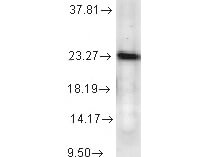Datasheet is currently unavailable. Try again or CONTACT US
p23 Antibody
Mouse Monoclonal JJ6 IgG1
200-301-G25
100 µg
Liquid (sterile filtered)
WB, IHC, IF, IP
Human, Mouse, Chicken, Guinea Pig, Rabbit, S. cerevisiae
Mouse
This product is discontinued
Product Details
Anti-p23 (MOUSE) Monoclonal Antibody - 200-301-G25
co chaperone p23, PTGES3, TEBP, telomerase binding protein p23, unactive progesterone receptor 23kDa, Hsp90 co-chaperone, Progesterone receptor complex p23, Cytosolic prostaglandin E2 synthase
Mouse
Monoclonal
IgG1
Target Details
PTGES3 - View All PTGES3 Products
Human, Mouse, Chicken, Guinea Pig, Rabbit, S. cerevisiae
Recombinant Protein
p23 Antibody was produced in mice by repeated immunizations raised against a recombinant human full length p23 protein.
Anti-p23 Antibody was purified by Protein G chromatography. A BLAST analysis was used to suggest cross-reactivity with p23 from Human, Mouses, Rabbit, Chicken, Guinea pig, and S. cerevisiae (lower) based on 100% homology with the immunizing sequence. Cross-reactivity with p23 from other sources has not been determined. Heat Shock research.
Q15185 - UniProtKB
NP_006592.3 - NCBI Protein
Application Details
IF, IHC, IP, WB
Anti-p23 Antibody is tested for use in WB, IP, IF, IHC, and ELISA. Expect a band approximately ~23kDa protein corresponding to the molecular mass of p23 on SDS PAGE immunoblots. Specific conditions for reactivity should be optimized by the end user.
Formulation
1mg/mL by UV absorbance at 280 nm
0.02 M Potassium Phosphate, 0.15 M Sodium Chloride, pH 7.2
50% (v/v) Glycerol
Shipping & Handling
Dry Ice
Store vial at -20° C prior to opening. Aliquot contents and freeze at -20° C or below for extended storage. Avoid cycles of freezing and thawing. Centrifuge product if not completely clear after standing at room temperature. This product is stable for several weeks at 4° C as an undiluted liquid. Dilute only prior to immediate use.
Expiration date is one (1) year from date of receipt.
p23 is a highly conserved ubiquitous protein, known to have an important function as a cochaperone for the hsp90 chaperoning system. Studies have revealed that p23 is a small protein (18 to 25 kDa) with a simple structure. p23 does not have any structural
homology with any other known proteins. p23 was first discovered as a part of the Hsp90-progesterone receptor complex along with hsp70, p54 and p50. p23 is a phosphor-protein, which is highly acidic and has an aspartic acid-rich c-terminal domain. Numerous studies have found p23 to be associated with other client proteins like Fes tyrosine kinase, the heme regulated kinase HRI, hsf1 transcription factor, aryl hydrocarbon receptor, telomerase, and Hepadnavirus reverse transcriptase. In spite of several years of study, the exact functional significance of p23 is still not clear. p23 is thought to be involved in the adenosine triphosphate–mediated hsp90 binding of client proteins. Since many hsp90 client proteins are involved in oncogenic survival signaling, a recent study has concluded p23 to be a promising target in leukemic apoptosis. Hsp90 and its co-chaperone p23 are certainly among the emerging anti-tumor targets in oncology.
This product is for research use only and is not intended for therapeutic or diagnostic applications. Please contact a technical service representative for more information. All products of animal origin manufactured by Rockland Immunochemicals are derived from starting materials of North American origin. Collection was performed in United States Department of Agriculture (USDA) inspected facilities and all materials have been inspected and certified to be free of disease and suitable for exportation. All properties listed are typical characteristics and are not specifications. All suggestions and data are offered in good faith but without guarantee as conditions and methods of use of our products are beyond our control. All claims must be made within 30 days following the date of delivery. The prospective user must determine the suitability of our materials before adopting them on a commercial scale. Suggested uses of our products are not recommendations to use our products in violation of any patent or as a license under any patent of Rockland Immunochemicals, Inc. If you require a commercial license to use this material and do not have one, then return this material, unopened to: Rockland Inc., P.O. BOX 5199, Limerick, Pennsylvania, USA.

